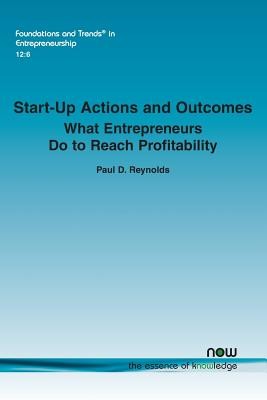
- We will send in 10–14 business days.
- Author: Paul D Reynolds
- Publisher: Now Publishers
- Year: 2016
- ISBN-10: 168083228X
- ISBN-13: 9781680832280
- Format: 15.6 x 23.4 x 0.7 cm, softcover
- Language: English
- SAVE -10% with code: EXTRA
Reviews
Description
The primary objective of Start-up Actions and Outcomes: What Entrepreneurs Do to Reach Profitability is to provide a description of the firm creation process based on five harmonized data sets from four countries that track the business creation process. The second objective is to explore the role of start-up activities on the outcomes for these nascent ventures. Outcomes include not only whether they reach profitability or disengage but how long it takes to achieve a resolution. The sooner a start-up team can determine if a nascent venture is profitable or hopeless, the lower the sunk costs.
The presentation begins with a review of the conceptualization of business creation. This is followed by a discussion of assessments of the role of business planning, the start-up activity that has received the most attention in relation to outcomes. A summary of the Panel Study of Entrepreneurial Dynamics (PSED) protocol describes the basis for the five cohort data set. To identify the impact of different background factors and start-up domains on outcomes, two assessments are completed. First, linear additive models are developed using stepwise regression. Second, interactions among factors are identified using a three level decision tree assessment. In both, there are major differences related to the host country and the total amount of start-up activity. To identify the impact of specific start-up domains, the assessments are replicated without measures of total start-up activity. The final section summarizes the major patterns and the implications for those starting new firms, developing public policy, or planning the next stages of research.
EXTRA 10 % discount with code: EXTRA
The promotion ends in 20d.19:32:59
The discount code is valid when purchasing from 10 €. Discounts do not stack.
- Author: Paul D Reynolds
- Publisher: Now Publishers
- Year: 2016
- ISBN-10: 168083228X
- ISBN-13: 9781680832280
- Format: 15.6 x 23.4 x 0.7 cm, softcover
- Language: English English
The primary objective of Start-up Actions and Outcomes: What Entrepreneurs Do to Reach Profitability is to provide a description of the firm creation process based on five harmonized data sets from four countries that track the business creation process. The second objective is to explore the role of start-up activities on the outcomes for these nascent ventures. Outcomes include not only whether they reach profitability or disengage but how long it takes to achieve a resolution. The sooner a start-up team can determine if a nascent venture is profitable or hopeless, the lower the sunk costs.
The presentation begins with a review of the conceptualization of business creation. This is followed by a discussion of assessments of the role of business planning, the start-up activity that has received the most attention in relation to outcomes. A summary of the Panel Study of Entrepreneurial Dynamics (PSED) protocol describes the basis for the five cohort data set. To identify the impact of different background factors and start-up domains on outcomes, two assessments are completed. First, linear additive models are developed using stepwise regression. Second, interactions among factors are identified using a three level decision tree assessment. In both, there are major differences related to the host country and the total amount of start-up activity. To identify the impact of specific start-up domains, the assessments are replicated without measures of total start-up activity. The final section summarizes the major patterns and the implications for those starting new firms, developing public policy, or planning the next stages of research.


Reviews